November 10, 2021
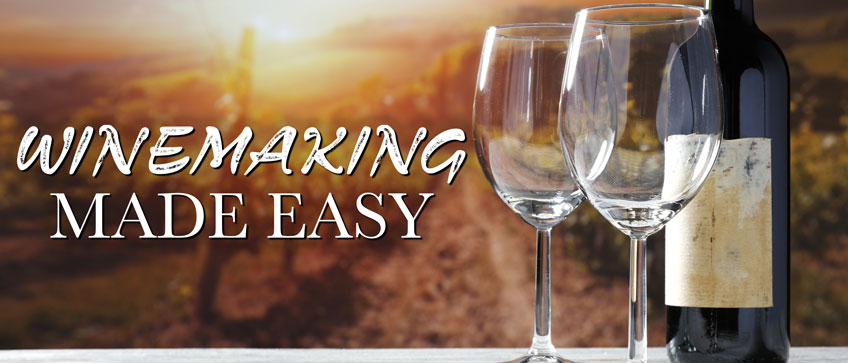
As satisfying as it is to pop the cork off of a bottle of wine, it is even more satisfying to taste your homemade wine. From chardonnay to zinfandel, you can easily make your favorite wine! It's hard to believe but not all good wine requires stomping grapes or a long-barrel-aged fermentation period. There are easy-to-use kits that have everything you need to make your own wine! So, if you happen to be feeling a little bored locked in your home or maybe you just want to explore a new hobby, this is the guide for you.
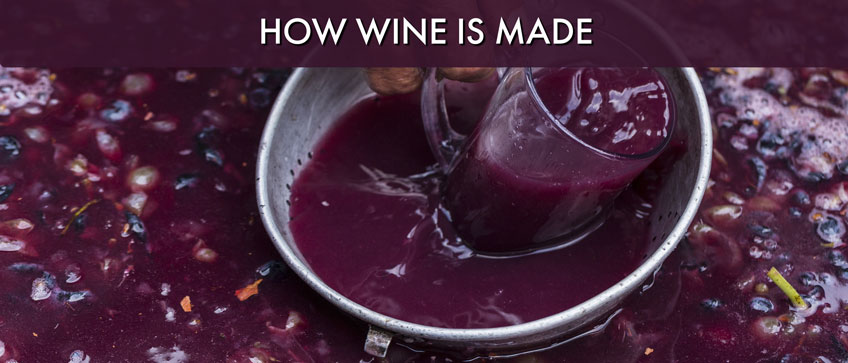
How Wine is Made
Wine is typically made by using a more complicated multi-step process that includes harvesting the right and ripe grapes. The grapes then, have to be prepared for fermentation by removing the stems and preventing them from spoiling with a sulfur dioxide treatment. We then proceed into the yeast addition, in which small sugar-eating yeasts are added to the grapes to consume the grape sugars and make alcohol.
Then, the most important step, fermentation. This process is different for each winemaker and it is what develops the signature wines for each winemaker. Most wines take at least 5-21 days to ferment sugar into alcohol; however, some rare styles take 50 days to up to 4 years to fully ferment. Winemakers will press the skins to release even more wine.
After the initial fermentation period, there is the second fermentation period, known as malolactic fermentation. As red wine starts to settle, the second fermentation stage starts and consists of little microbes converting sharp-tasting malic acid into creamier, chocolatey lactic acid. Almost all red wines go through Malolactic Fermentation (MLF) but only a few white wines, like Chardonnay, go through this second fermentation.
The next step is aging the wine, which can occur in a variety of vessels from barrels to clay tanks. The more time a wine rests, the more chemical reactions can occur to develop rich and complex flavors in the wine. This aging process also mellows out strong acidity, making the wine smoother and easier to drink.
After all the aging is complete, we move into blending the wine. Typically, winemakers blend grape varieties together or different barrels of the same grape to make the final wine. Blending wine can be challenging because you have to use your sense of texture on your palate instead of your nose.
The next step is clarifying the wine. The addition of fining agents removes all suspended particulates and proteins in the wine from the winemaking process. Then, the wine gets passed through a filter for sanitation to reduce bacteria spoilage. There are also unfiltered wines because some winemakers believe filtering removes the texture and quality of the wine.
Next, the wine is bottled and labeled to prevent oxygen from accessing the wine and prematurely aging the wine before it is ready for consumption. Finally, some but definitely not most wines will need to be bottle-aged. This will make the wine taste even better when you finally have the opportunity to taste it. However, many wines are ready to drink once they're bottled.
With such a complicated winemaking process, it may feel overwhelming when you consider making your own wine. Luckily, winemaking kits are designed to simplify this process, making it easier to make wine at home with minimal effort. You may be surprised at how complex you can get your wine with a simplified process.
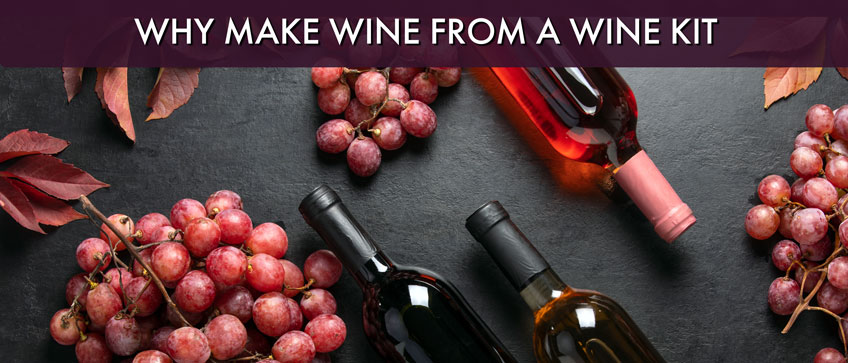
Why Make Wine From A Wine Kit
It saves you money and space.
Typical winemaking equipment can run you up to $200 or more! A wine kit includes everything you need to make your wine, sometimes even including the equipment but for significantly less! Also, with the minimal equipment they provide for you, you don't have to worry about seeking a place to store it all. You can make wine with minimal equipment and still get a great-tasting wine.
It yields a lot of wine for the price.
A kit typically makes 6 gallons (23 L) and yields 30 bottles of wine, so your wine will actually cost around $3 to $7, depending on the kit. With 30 bottles of wine, you're going to find yourself needing a wine refrigerator to store it all! This will last you quite a while and you can get a higher quality product when you make it yourself than buying an inexpensive bottle of wine. Trust us, people are going to be asking about your wines when they get a chance to try them.
It saves you time.
With a wine kit, you'll find it only takes 30 minutes to put everything together before you place it in the fermenter! Remember all the complicated stages we discussed previously? You can forget about all of that because the kit has everything prepared for you and practically ready to ferment. Your ingredients are measured out perfectly, which saves you so much time for figuring out a proper recipe that works.
It's easy to do.
With all the ingredients pre-measured, a kit basically allows you to just mix everything together and start fermenting almost immediately. Since you aren't starting with raw grapes, there is significantly less processing needed and steps that can be skipped. A kit saves you hours of labor and minimizes the risk of you making a mistake. This is a great way to get into and learn how to make wine without making it feel so daunting. This is just a jumping-off point for those who want to eventually get serious about making wine.
It saves on the clean-up and mess.
Winemaking can be a messy process, especially with all the equipment and multiple stages. A wine kit offers minimal equipment, a simple set-by-step pan, pre-packaged, and measured ingredients. This minimizes so much mess and fusses when it comes to winemaking. You'll have very little to worry about except for when your wine will be ready to drink.
Modern wine kits produce great wine.
Previously, wine kits came with canned concentrate, which didn't deliver the most delicious results. Modern-day wine kits now come with a juice base that is only slightly concentrated, which is much more appealing to work with and results in a really delicious wine. The higher-end wine kits will result in a wine that you would typically pay $10 to $20 for.
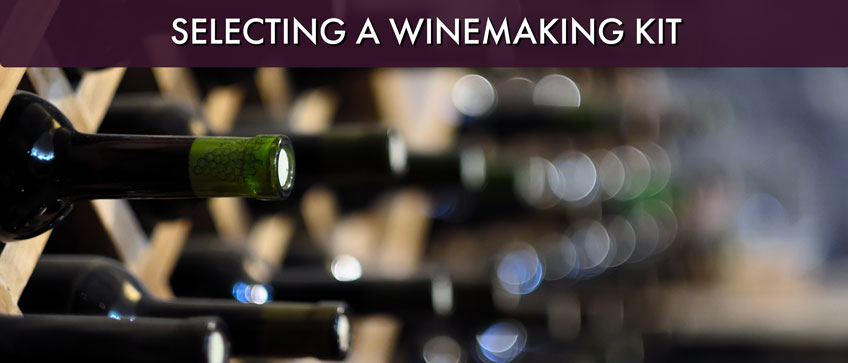
Selecting a Winemaking Kit
Wine Quality
There are various wine qualities and kits to choose from when you are searching for your perfect winemaking kit. Here are some terms you may often see when you're shopping for a winemaking kit.
Budget - You won't see this term on the label but the more affordable kits are slightly lower in quality. These kits will yield a good quality table red or white wine but they don't use specific grapes to develop the wine. These kits are often smaller and great for beginning winemakers to understand the process of making wine without breaking the bank.
Cru Speciality - These are dessert wines of high quality. These dessert wines are ideal for celebrating or just enjoying as a nightcap. Sweet and complex, you will find these wines easy to make and easy to enjoy.
Cru Select - These wine kits include the highest quality juices. With a wide selection of varietals to choose from, these red and white wines are high quality and so enjoyable. These are premium quality wines, produced from juices, not concentrates.
Cru International - These wine kits offer international varieties of wines that use grapes that may be typically hard to find in your region. This is a great way to make some of your international favorites without the struggle of hunting down these varieties of grapes or living in that country.
Grand Cru - The Grand Cru wines are made with high quality grape juice and concentrate that require shorter fermentation times and taste delicious with little or no aging. These top-tier wine kits include premium juices to create top-shelf red and white wines.
En Premier - These kits offer the most authentic craft winemaking experience, enabling you to create craft age-worthy wines of distinction. These are the highest quality winemaking kits that will deliver you a genuine winemaking experience. These kits are designed to deliver you aged wines without the long crafting and aging time.
Varietal
While budget kits may just be labeled as "red wine", more premium kits offer wine varietals made from particular grapes. So, instead of getting a generic red, you can pick and choose the particular wine you're making. This makes your wine much more complex, high quality, and you can actually predict how the wine might taste in the end.
Total Dissolved Solids
When it comes to discussing the differences between grape concentrate and grape juice used for winemaking, we need to discuss total dissolved solids (TDS). TDS is what is remaining once all the water has been removed. Essentially, the more total dissolved solids, the more aroma and flavor compounds the resulting wine will contain. Fresh, not-from-concentrate juices have more TDS (means more flavor) and straight concentrate kits have the lower levels. The super-premium grape skin kits have the most TDS, resulting in the most flavorful wine.
Levels of TDS
100% Concentrate
With a low level of TDS, these wines mature quickly but will taste as good as they will ever taste after the maturation period. Just because these wines are made using all concentrate, it doesn't mean it results in a bad wine, it just won't be a premium level wine or lack in complexity. If you need wine quickly or you are a beginning winemaker, this is a great set to start with.
Mid-Volume Kits
These wine kits typically contain around 7.5 liters (2 gallons) in volume and with varietal juice content and higher levels of TDS. These kits mature a bit slower that pure concentrate. Although they drink quite well after only a month maturing in the bottle, they show their best after approximately 3 to 6 months for whites, and 6 to 12 months for reds. This maturation time will depend on your kit and winemaking conditions.
Upper-Mid-Volume
Upper-mid-volume kits contain around ten liters (2.6 gallons) in size is a jump up in both juice and TDS content. These kits are slower to mature than mid-volume, but provide a greater reward after appropriate aging. The ideal aging time is six months for whites and 12 months for reds for the best results. Varietal differentiation is usually stronger in this tier and you'll be further rewarded after two more years of aging.
Premium Kits
Premium kits deliver 15 liters (4 gallons) or so of high levels of varietal juice and high TDS. These kits will take several months of aging after the bottling process. With these kits, most whites need at least six months and most reds need at least 12 months to reveal the rich aromas and flavors. These premium kits can surpass the mid-volume kits in taste and aroma within three months. But they continue to develop exceptionally well with more time. Ideally, most premium kits will actually improve significantly with three to five more years of aging, if they're cellared well.
Super-Premium Kits
Included in these super-premium kits, are the highest levels of TDS of non-grape pack kits and the finest (and most expensive) juices available. These juices are typically from single, delimited vineyards ensuring the quality and enhancing the final product. These super-premium kits weigh in at 15-16 liters (4-4.2 gallons) and they require patient aging to deepen and develop rich flavors. These wines take an even longer period than the premium kits to develop to their peak. These white wines will take a minimum of 18 months before revealing their characteristics and the reds can take at least 24 months before they really blow your palate out of the water.
These kits are easily distinguishable from the premium kits by their price. These kits high prices are due to the fact that high-end juices cost more, especially if they're from prestigious areas like Napa, Sonoma, Marlborough, or the Stellenbosch.
Grape Skin Kits
These kits can produce 15+ liters (4 gallons) in liquid volume and come with an added package of grape solids and high-quality grape juices. Grape skin kits have the highest levels of dissolved solids, but this makes creates a drinkability trade-off issue. The skins add phenomenal levels of dissolved solids but also, quite a bit of harshness in a young wine. As they age, they drop their harsh flavors and come into smooth maturity, replicating the finest commercial wines from fresh grapes.
With the additional level of solids and grape material, these kits aren't designed for early drinking: they're made for a much longer maturation period. As with all wine kits, you can drink them at a much younger age, but these will get significantly better as time passes. Allowing them to age for two years quill only reveals what they have to offer and in another two years, it will reach its peak.
Full-Size Kits
There are kits available that start at the full 23 liters (6 gallons) in volume. These are distinguished from single-strength grape juice kits in that they are made at least in part from reconstituted concentrate. In some cases, this may be a bit difficult to determine, as packaging laws allow rehydrated concentrate to be sold under the label "pure juice." However, all major manufacturers include labeling that indicates the presence of concentrate in their full-volume kits.
Price
You can find winemaking kits in a wide price range, from budget to high-end. You can find great kits in every price range and a lot of your resulting wine comes from your process. As we have just discussed above, price is directly correlated with the volume you can produce with your kit and the quality of the ingredients included in your kit. The more total dissolved solids (TDS) and high-quality varietal juice included in the kit, the higher the price of the kit. However, this also yields a much higher-quality and flavorful wine.
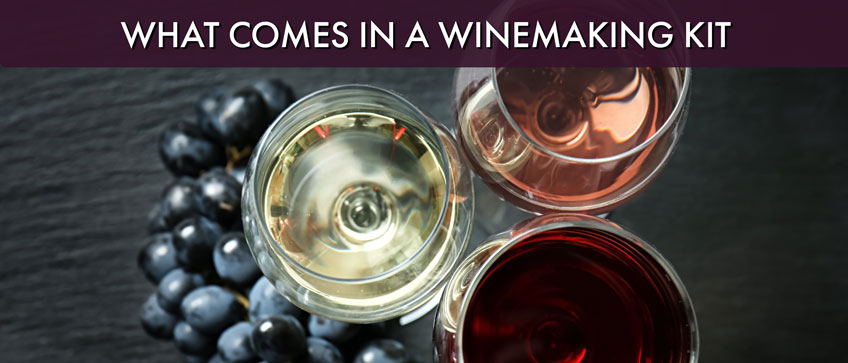
What Comes in a Winemaking Kit
There are some smaller winemaking kits that include everything you need to make a batch of wine. However, many "wine kits" are ingredient kits that have everything you need besides the equipment to get started. While the all-inclusive smaller kits are great for beginners, if you decide you want to brew more than one gallon, you'll need to consider investing in some basic equipment.
All-Inclusive Winemaking Kits
These All-Inclusive Winemaking Kits tend to be smaller but they do include everything you'll need to make your wine. Keep in mind that you are likely to only make about one gallon or so of wine with these kits. You will also need to purchase bottling equipment because this isn't included.
What's typically included:
- Glass Carboy
- Funnel
- Racking Cane
- Rubber Stopper
- Transfer tubing
- Tubing clamp
- Airlock
- Thermometer
- A Guide to Making Wine
- Grape Juice with yeast, oak, and additives
- Zork Closures (5)
- Sanitizer
Wine Ingredient Kits
These Wine Ingredient Kits only include all the essential ingredients in the perfect measurements needed to make an exact volume of wine. While these kits come in a wider variety of qualities, these kits don't include any equipment. So, you will need to gather up some basic equipment to start making your wines.
What's typically included:
- Grape Juice or Concentrate
- Yeast - To make wine, yeast is essential. When buying your wine kit check the expiry date to make sure it hasn't been sitting on a shelf for a long time. Dried yeast becomes less viable after about a year.
- Bentonite - Used mainly in white and rose wines, bentonite is a clay that is used to clarify and fine wines by bonding with particles suspended in the grape juice, clearing the wine.
- Oak Chips - Occasionally, you will find oak chips in the kit. These are used to replicate the barrel aging process of certain wines, particularly red wines.
- Stabilizer - Wine stabilizers are added to the wine after fermentation to prevent re-fermentation in the bottle. A stabilizer is made of potassium sorbate and is stirred through the wine. A stabilizer won't stop an active fermentation, it must be added once fermentation is completely finished, prior to clearing and bottling. It will also help keep the flavor stable during long storage.
- Fining Agents - Clearing the wine by removing floating particulates ensures a crystal clear finished product. This clear and drinkable wine is achieved through fining agents. The finings work by binding particles and yeast together that are suspended in the wine. These particles then fall to the bottom of the fermenting vessel, separated from the wine.
What you'll need:
- Brew Bucket - A brew bucket makes an ideal primary fermentation vessel. This is where you can combine all your ingredients and start the fermentation process. These buckets are
- inexpensive and very versatile for making a variety of beverages.
- Glass Carboy - This is an essential vessel for winemaking and can be found in a variety of sizes. A carboy is incredibly versatile and can be used for making a variety of beverages. This is where fermentation takes place during the winemaking process.
- Stirring Spoon - A long handled spoon or paddle is necessary for mixing together the grape juice and water as well as incorporating the finings agents and degassing the wine.
- Funnel - Minimize the mess and spills during liquid transfer, a funnel is an essential.
- Racking Cane - Easily transfer the wine after the primary fermentation has completed without risk of making a mess or spilling.
- Rubber Stopper - Important for for your fermentation, this stopper will seal in your fermenting wine, preventing oxidation and contamination. Also, it allows your airlock to handle the gas release.
- Transfer tubing - Transfer tubing is important for precisely transfering large quantities of liquids.
- Tubing clamp - A small part but important for securing attachments.
- Airlock - This little piece of equipment allows the gases to escape during the fermentation process without opening your wine up to contamination and oxidation.
- Thermometer
- Sanitizer - It is very important to keep all your equipment really clean to prevent contamination during the winemaking process. To ensure you get a true the truest and purest flavors from your wines, your equipment should be snatized before and after use.
- Wine Bottles
- Corks
- Corker
- Bottling Wand - This makes it much easier to siphon the wine into bottles.
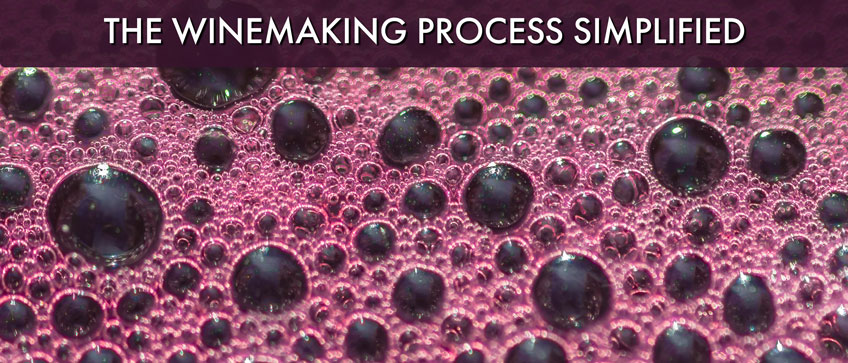
The Winemaking Process Simplified
You may be feeling a little overwhelmed at the moment but don't worry, the beauty of winemaking kits is that they simplify the winemaking process. While wine kits vary, the process is mostly the same and we're going to give you a brief summary of the winemaking process here.
- 1. Dilute the grape juice - Pour the entire contents of the juice or concentrate bag into a sanitized brew bucket/fermenter. Dilute the juice with water to the recommended amount of liters. The plastic pouch can be filled with recently boiled, warm water to rinse out the remaining grape juice. Mixed thoroughly.
- Add bentonite - If you're making a rose or white wine, add the Bentonite at this stage if it is included in the kit. Sprinkle onto the surface, wait 15 minutes then mix again with a sanitized spoon.
- 2. Add yeast - Add the yeast by sprinkling it onto the surface of the wine. Cover with the lid and airlock and wait for fermentation to take place.
- 3. Ferment - Allow to ferment at between 68 - 77° (20 - 25°C), as close to 68°F as possible. You should follow the instructions from your kit but we recommend transferring once fermentation is complete after about 10 - 15 days for white and rose wines and about 15 - 20 days for red wines. *Important - Take a hydrometer reading at this point to ensure fermentation is actually complete the final gravity for the wine should be between 0.990 and 0.995.
- 4. Add stabilizer - After fermentation is complete and the wine has been transferred to a new fermenting vessel, the stabilizer needs to be added to the wine. The stabilizer won't stop active fermentation but rather prevent future fermentation, so it's important to ensure fermentation has finished.
- 5. De-gass stabilizer - De-gassing means to agitate all of the carbon dioxide created by the yeast during fermentation out of the wine. Take a sanitized spoon or paddle and stir/swirl the wine for a couple of minutes. This process is repeated a few times a day for 3 - 4 days. The idea is not to vigorously beat the wine just to agitate it enough to encourage the CO2 out.
- 6. Clear the wine - After this degassing stage, it's time to clear the wine by adding finings. Depending on the wine kit you purchase, it may have multiple packets of finings, one for this stage and one for the following day.
- 7. Wait for finings to work - The finings takes approximately 3 to 7 days to work and clear the wine, depending on the temperature. Check regularly to see when the wine will be clear.
- 8. Bottle the wine - The final step that requires any work is to sanitize the bottles. Fill them, and cork them. Be careful to not disturb the sediment by bottling straight from the fermenter. A bottling wand or siphon can really help with the bottling process. If you are siphoning into bottles, it may be best to transfer the wine off of the yeast to avoid disturbing it.
- 9. Bottle aging - Depending on the wine, it will need to be bottled aged from 2 months to several years. Not all wines will need this extra maturation time but the ones that do will develop into a complex, rich, and flavorful wine.
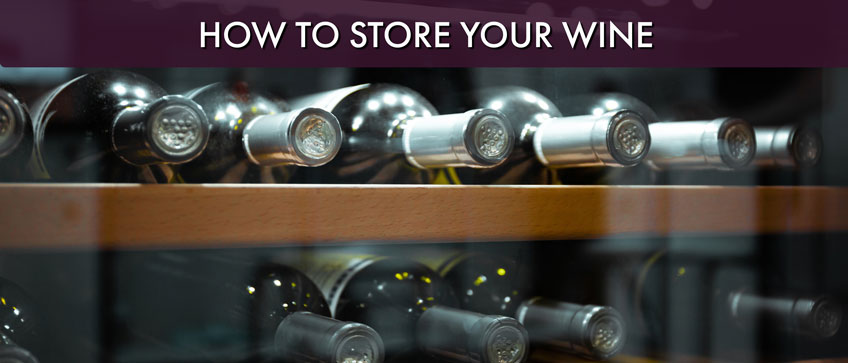
How to Store Your Wine
Now that you've made your delicious wine, you may need to bottle age it or just store it safely for consumption. As you know, wine can be fickle and delicate beverage that needs to be properly stored or it could easily go bad before its time. The most ideal storage is temperature-controlled, humidity-controlled, and provides UV protection. We think the ideal way to store wine is in a wine refrigerator.
Only a wine refrigerator can provide the perfect environment needed to protect your wines from prematurely aging, allowing you to cellar your wine or serve it at its ideal temperature. When you're cellaring your wines, it is essential that your temperature is regulated and consistent. A high-quality wine refrigerator maintains a consistent and unwavering temperature that protects your wines from spoiling. As a winemaker, your precious time and effort won't be wasted because it will all be protected and properly store with a wine refrigerator.
Humidity control is a very underrated factor in storing wine and the only refrigerators that do this best are wine refrigerators. They are designed to maintain the most optimal humidity to prevent corks from drying out or becoming too wet, both conditions would lead to your wines spoiling.
Most wine refrigerators have a UV protection tint or coating on the door to prevent light from damaging and spoiling your wines. Additionally, many wine refrigerators have vibration dampening technology to prevent damage to your wines. They also store your wine horizontally, which is ideal for maintaining the quality of your wines. Not to mention, a wine refrigerator allows you to organize your growing collection.
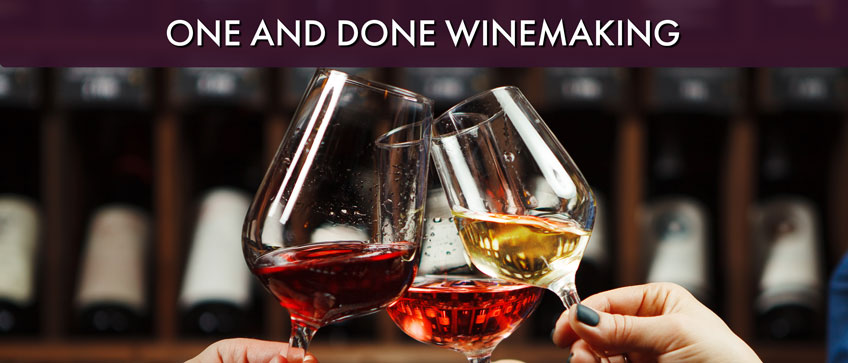
One and Done Winemaking
These all-inclusive winemaking kits are making winemaking accessible to the everyday person. With limited equipment and an ingredients kit, you can create something truly exceptional worthy of being on the top shelf! Whether you're making your own wine or you need to store your current collection, our team of experts is here to help! Contact our team at 800-710-9939.


 Single Faucet Kegerator Beer Dispensers
Single Faucet Kegerator Beer Dispensers Dual Faucet Two Tap Kegerators
Dual Faucet Two Tap Kegerators Triple Faucet Three Tap Kegerators
Triple Faucet Three Tap Kegerators Undercounter Built-In Kegerators
Undercounter Built-In Kegerators Outdoor Kegerator Beer Dispensers
Outdoor Kegerator Beer Dispensers Commercial Kegerators
Commercial Kegerators Mini Kegerators
Mini Kegerators Cold Brew & Nitro Coffee Dispenser Kegerators
Cold Brew & Nitro Coffee Dispenser Kegerators Carbonated Water Kegerators
Carbonated Water Kegerators Home Brew Kegerators
Home Brew Kegerators 15" Kegerators
15" Kegerators Kombucha Equipment
Kombucha Equipment Guinness® Dispensing Kegerators
Guinness® Dispensing Kegerators Vending Kegerators
Vending Kegerators Wine Kegerators
Wine Kegerators Kegerator Cabinets
Kegerator Cabinets Kegerator Covers and Accessories
Kegerator Covers and Accessories Kegerators
Kegerators Kegerator Conversion Kits
Kegerator Conversion Kits Kegs & Keg Accessories
Kegs & Keg Accessories Beer Faucets
Beer Faucets Beer Shanks
Beer Shanks Draft Beer Towers
Draft Beer Towers Keg Taps Couplers
Keg Taps Couplers Regulators & Gas Equipment
Regulators & Gas Equipment Beer & Gas Line Hose
Beer & Gas Line Hose Co2 and Nitrogen Air Tanks
Co2 and Nitrogen Air Tanks Beer Line Cleaning Equipment
Beer Line Cleaning Equipment Drip Trays
Drip Trays System Fittings
System Fittings Jockey Boxes
Jockey Boxes Keg Beer Party Pumps
Keg Beer Party Pumps Glassware & Accessories
Glassware & Accessories Guinness® Dispensing Equipment
Guinness® Dispensing Equipment Remote Glycol Systems
Remote Glycol Systems Wine Cooler Refrigerators
Wine Cooler Refrigerators Wine Cellar Cabinets
Wine Cellar Cabinets Wine Racks
Wine Racks Cooling Units
Cooling Units Wine Dispensing Systems
Wine Dispensing Systems Wine Glasses
Wine Glasses Wine Accessories
Wine Accessories Howard Miller Wine & Spirits Furniture
Howard Miller Wine & Spirits Furniture Wine Making
Wine Making Nitro Hot Draft System
Nitro Hot Draft System Ready to Drink Bag-in-a-Box Coffee Dispensing Equipment
Ready to Drink Bag-in-a-Box Coffee Dispensing Equipment Nitrogen Infusers
Nitrogen Infusers Nitrogen Tanks & Generators
Nitrogen Tanks & Generators Nitrogen Beer Regulators
Nitrogen Beer Regulators Nitro Cold Brew Coffee Kegs
Nitro Cold Brew Coffee Kegs Cold Brewed Coffee Tools
Cold Brewed Coffee Tools Espresso Machines
Espresso Machines Cleaning Equipment
Cleaning Equipment Outdoor Appliances
Outdoor Appliances ADA Appliances
ADA Appliances Panel Ready Appliances
Panel Ready Appliances Commercial Grade Appliances
Commercial Grade Appliances Beverage Centers
Beverage Centers Refrigerators
Refrigerators Drawer Refrigerators
Drawer Refrigerators Ice Makers
Ice Makers Water Dispensers & Accessories
Water Dispensers & Accessories Freezers
Freezers Home Brew Equipment Kits
Home Brew Equipment Kits Fermentation Equipment
Fermentation Equipment Boiling and Mashing Equipment
Boiling and Mashing Equipment Home Brew Beer Kegs
Home Brew Beer Kegs Home Brew Kegerator Conversion Kits
Home Brew Kegerator Conversion Kits Brewing Tools
Brewing Tools Home Brew Ingredients
Home Brew Ingredients Cleaning Chemicals
Cleaning Chemicals Test Equipment
Test Equipment Home Brew Beer Bottles and Bottling Equipment
Home Brew Beer Bottles and Bottling Equipment Brewery Fittings
Brewery Fittings Draft Beer Equipment
Draft Beer Equipment Homebrewing Equipment
Homebrewing Equipment Wine Equipment
Wine Equipment Luxury Appliances and Refrigeration
Luxury Appliances and Refrigeration Coffee Equipment
Coffee Equipment Home Bar & Barware
Home Bar & Barware Kombucha
Kombucha The Beverage Blog
The Beverage Blog Frequently Asked Beer Questions
Frequently Asked Beer Questions Shop by Brand
Shop by Brand Shop by Category
Shop by Category



